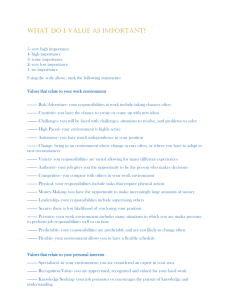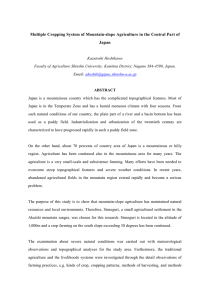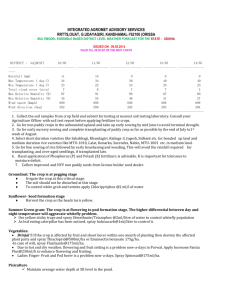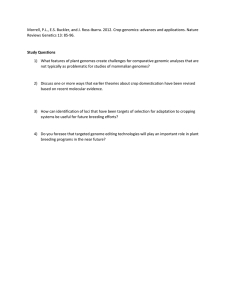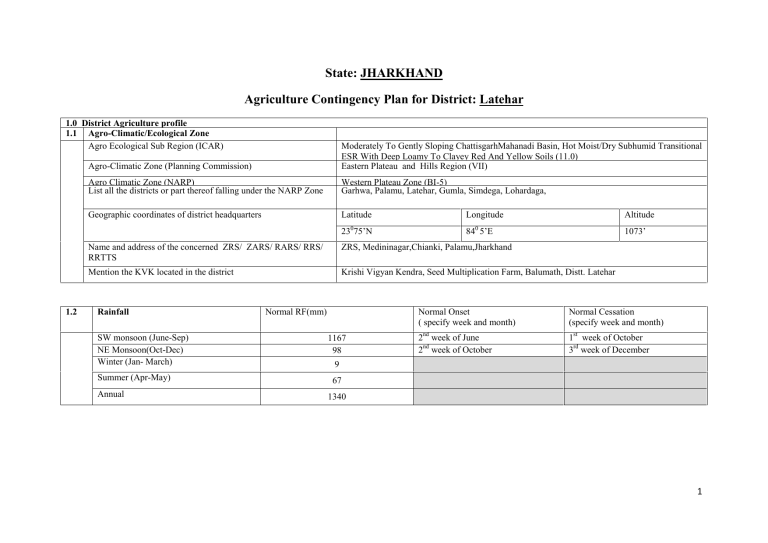
State: JHARKHAND
Agriculture Contingency Plan for District: Latehar
1.0 District Agriculture profile
1.1 Agro-Climatic/Ecological Zone
Agro Ecological Sub Region (ICAR)
Moderately To Gently Sloping ChattisgarhMahanadi Basin, Hot Moist/Dry Subhumid Transitional
ESR With Deep Loamy To Clayey Red And Yellow Soils (11.0)
Eastern Plateau and Hills Region (VII)
Agro-Climatic Zone (Planning Commission)
District agriculture profile
Agro Climatic Zone (NARP)
List all the districts or part thereof falling under the NARP Zone
Western Plateau Zone (BI-5)
Garhwa, Palamu, Latehar, Gumla, Simdega, Lohardaga,
Geographic coordinates of district headquarters
1.2
Latitude
Longitude
Altitude
23075’N
840 5’E
1073’
Name and address of the concerned ZRS/ ZARS/ RARS/ RRS/
RRTTS
ZRS, Medininagar,Chianki, Palamu,Jharkhand
Mention the KVK located in the district
Krishi Vigyan Kendra, Seed Multiplication Farm, Balumath, Distt. Latehar
Rainfall
SW monsoon (June-Sep)
NE Monsoon(Oct-Dec)
Winter (Jan- March)
Summer (Apr-May)
Annual
Normal RF(mm)
1167
98
Normal Onset
( specify week and month)
Normal Cessation
(specify week and month)
2nd week of June
2nd week of October
1st week of October
3rd week of December
9
67
1340
1
1.3
Land use
pattern of the
district
Geographical
area
Area (‘000 ha)
379.1
Cultivable
area
Forest
area
Land under
nonagricultural use
Permanent
pastures
Cultivable
wasteland
86
162.4
13.6
1.124
6.5
1. 4
Major Soils (common names like red sandy
Area (‘000 ha)
loam deep soils (etc.,)*
Deep fine loamy soils
1.06
Gravelly loamy soils
0.9
Fine loamy soils
0.9
Deep fine soils with clayey surface
0.1
Source – Fertilizer and agril. Statistics eastern region 2003-04
Current
fallows
Other
fallows
24.7
45.8
33.3
29
26
25
4.2
Cropping intensity %
Net sown area
Area sown more than once
Gross cropped area
Source – SREP
59.6
12.6
32.3
121
1.6
Irrigation
Area (‘000 ha)
Net irrigated area
Gross irrigated area
Rainfed area
Sources of Irrigation
Canals
Tanks
Open wells
Bore wells
Lift irrigation schemes
Micro-irrigation
Other sources (please specify)
247
Agricultural land use
Barren and
uncultivable
land
Percent (%) of total
Area (‘000 ha)
1.5
Land under
Misc. tree
crops and
groves
6.1
895
Number
Area (‘000 ha)
Percentage of total irrigated area
2
Total Irrigated Area
Pump sets
No. of Tractors
No. of blocks/
(%) area
Groundwater availability and use* (Data
Tehsils
source: State/Central Ground water
Department /Board)
Over exploited
Critical
Semi- critical
Safe
Wastewater availability and use
Ground water quality
*over-exploited: groundwater utilization > 100%; critical: 90-100%; semi-critical: 70-90%; safe: <70%
1.7
Area under major field crops & horticulture
1.7
Major field crops
cultivated
Irrigated
Paddy
Maize
Pigeonpea
Wheat
Blackgram
Source – Agriculture statistics of Jharkhand at a glance 2004
Area (‘000 ha)
Kharif
Rainfed
Horticulture crops - Fruits
Lemon
Mango
Guava
Horticulture crops Vegetables
Quality of water (specify the problem
such as high levels of arsenic, fluoride,
saline etc)
Total
324
141
140
Total
Total
16.6
14.6
9.9
1.9
2.1
Irrigated
Rabi
Rainfed
Area (‘000 ha)
Irrigated
Total
Summer
Grand total
Rainfed
3
Tomato
Potato
Bhindi
Brinjal
Chilli
Medicinal and Aromatic crops
321
1205
646
477
353
Plantation crops
Fodder crops
1.8
1.9
1.10
Livestock
Male (‘000)
Non descriptive Cattle (local low yielding)
Crossbred cattle
Non descriptive Buffaloes (local low yielding)
Graded Buffaloes
Goat
Sheep
Others (Camel, Pig, Yak etc.)
Commercial dairy farms (Number)
Poultry
Commercial
Backyard
Fisheries (Data source: Chief Planning Officer)
Female (‘000)
Total (‘000)
170.2
44.1
No. of farms
Total No. of birds (‘000)
A. Capture
i) Marine (Data Source: Fisheries
Department)
No. of fishermen
Boats
Mechanized
Nonmechanized
Nets
Mechanized
(Trawl nets,
Gill nets)
Storage facilities
(Ice plants etc.)
Non-mechanized
(Shore Seines,
Stake & trap nets)
4
No. Farmer owned ponds
No. of Reservoirs
No. of village tanks
ii) Inland (Data Source: Fisheries
Department)
B. Culture
Water Spread Area (ha)
Yield (t/ha)
Production (‘000 tons)
i) Brackish water (Data Source: MPEDA/
Fisheries Department)
ii) Fresh water (Data Source: Fisheries
Department)
1.11
1.11
Production and Productivity of major crops
Name of crop
Kharif
Production
('000 t)
Rabi
Productivity
(kg/ha)
Production
('000 t)
Summer
Productivity
(kg/ha)
Production
('000 t)
Productivity
(kg/ha)
Total
Production
('000 t)
Productivity
(kg/ha)
Crop
residue as
fodder
(‘000
tons)
Major Field crops (Crops identified based on total acreage)
1.12
Paddy
11.6
11.6
700
Maize
Pigeonpea
Wheat
Blackgram
25.6
8.2
0.5
25.6
8.2
2.1
0.5
1750
825
1105
225
Sowing window for 5 major
field crops (start and end of
normal sowing period)
Kharif- Rainfed
Kharif-Irrigated
Rabi- Rainfed
225
2.1
Rice
2nd week of June2nd week of August
1105
Maize
2nd week of May2nd week of July
Pigeonpea
Wheat
2nd week of June –
4th week of July
Blackgram
2nd week of June –
2nd week of July
2nd week of November –
2nd week of December
5
Rabi-Irrigated
1.13
1.14
What is the major contingency the district is prone to? (Tick mark)
Drought
Flood
Cyclone
Hail storm
Heat wave
Cold wave
Frost
Sea water intrusion
Pests and disease outbreak
Include Digital maps of
the district for
Regular
Occasional
None
Location map of district within State as Annexure I
Enclosed: Yes
Mean annual rainfall as Annexure-II
Enclosed: Yes
Soil map as Annexure-III
Enclosed: Yes
6
Annexure I
7
Annexure II
350
333
321
300
259
254
250
200
150
92.7
100
54.8
50
5
4
5
7
Jan
Feb
Mar
Apr
0
May
June
Jul
Aug
Sep
Oct
3
2
Nov
Dec
8
Annexure III
9
2.0 Strategies for weather related contingencies
2.1 Drought
2.1.1 Rainfed situation
Condition
Early season
drought (delayed
onset)
Delay by 2 weeks
June 4th week
Suggested Contingency measures
Agronomic measures
Major Farming
situation
Normal Crop /
Cropping system
Change in crop / cropping
system including variety
Up land
Up land paddy
Variety- Birsa vikas dhan
109,110, Birsa dhan 108,
Vandana, Anjali, Abhishek
Variety- Birsa vikash
maize-,Suwan composite
Variety-Pant Urd 19, Birsa
Urd-1,
Seed sowing behind the plough,
Hand weeding 20-25 DAS
Pigeonpea
Variety – Upas 120,ICPH
2671
Finger millet
Variety- Birsa marua 2,
A.404
Ploughing across the slope,
Earthing up 40-45 DAS after weed
control,
Two hand weeding at 25 and 45
DAS,
Spraying of Endosulfan 35 EC or
Nuvacron 40EC @0.2 to 0.3 %
solution
Transplanting 3-4 weeks after
seedling
Tomato
Variety- Pusa rubi,
Arka abha
Variety- Birsa vikas dhan
109,110, Birsa dhan 108,
Vandana, Anjali, Abhishek
Variety- Birsa Soybean1, JS
335,
Variety -Kanke safed,
Krishana
Maize
Blackgram
Medium land
Paddy
Soybean
Sesame
Remarks on
Implementation
Ploughing across the slope
Two hand weedings at 20 and 40
DAS
Seed sowing behind the plough
Hand weeding at 20-25 DAS
Weed management – 20 and 45 DAS
10
Condition
Early season
drought (delayed
onset)
Delay by 4 weeks
July 2nd week
Low land paddy
Paddy
Variety- Lalat,IR_64
Major Farming
situation
Normal
Crop/cropping
system
Up land paddy
Change in crop/cropping
system
Up land
Maize
Blackgram
Mid land
Variety – Upas 120,ICPH
2671
Finger millet
Variety- Birsa marua 2,
A.404
Tomato
Variety- Pusa rubi, Arka
abha
Variety- Birsa vikas dhan
109,110, Birsa dhan 108,
Vandana, Anjali, Abhishek
Soybean
Sesame
Suggested Contingency measures
Agronomic measures
Variety- Birsa vikas dhan
109,110, Birsa dhan 108,
Vandana, Anjali, Abhishek
Variety- Birsa vikash
maize2 ,Suwan composite
Variety – Pant Urd 19, Birsa
Urd 1,
Pigeonpea
Paddy
Seed sowing behind the plough
Variety- Birsa Soybean1, JS
335,
Variety -Kanke safed,
Krishana
Remarks on
Implementation
Seed supply
through NFSM
Ploughing across the slope
Ploughing across the slope,
Earthing up 40-45 DAS after weed
control,
Two hand weeding 25 and 45 DAS,
Spraying of endosulfan 35 EC or
Nuvacron 40EC @0.2 to 0.3 %
solution
Seed rate@ 8-10 kg /ha,
Transplanting 3-4 weeks after
seedling,
Weed management- 25-30 DAT
Mulching
Hand weeding at 20-25 DAS
Two weeding at 20-25 and 40-45
DAS
11
Condition
Early season
drought (delayed
onset)
Delay by 6 weeks
Major Farming
situation
Up land
Normal
Crop/cropping
system
Up land paddy
Seed supply
through NFSM
Ploughing across the slope
Implement supply
through RKVY
Pigeonpea
Variety – Upas 120,ICPH
2671
-Ploughing across the slope
-Earthing up 40-45 DAS after weed
control
-Two hand weeding 25 and 45 DAS
-Spraying of Indosulfan 35 EC or
Nuvacron 40EC @0.2 to 0.3 % solution
Finger millet
Variety- Birsa marua 2,
A.404
Variety- Pusa rubi, Arka
abha
Variety- Birsa vikas dhan
109,110, Birsa dhan 108,
Vandana, Anjali, Abhishek
Variety- Birsa Soybean1,
JS 335
Variety -Kanke safed,
Krishana
Variety- Lalat,IR_64
Blackgram
Tomato
Paddy
Soybean
Sesame
Paddy
Up land
Remarks on
Implementation
Hand weeding at 20-25 DAS
Maize
Major Farming
situation
Suggested Contingency measures
Agronomic measures
Variety- Birsa vikas dhan
109,110, Birsa dhan 108,
Vandana, Anjali, Abhishek
Variety- Birsa vikash
maize-2 ,Suwan composite
Variety – Pant Urd 19,
Birsa Urd 1,
July 4th week
Condition
Early season
drought (delayed
onset)
Delay by 8 weeks
August 2nd week
Change in crop/cropping
system
Normal
Crop/cropping
system
Up land paddy
Change in crop/cropping
system
Variety- Birsa vikas dhan
109,110, Birsa dhan 108,
Seed sowing behind the plough
Two weeding at 20-25 and 40-45 DAS
Seed sowing by Drum seeder
Suggested Contingency measures
Agronomic measures
Remarks on
Implementation
Seed supply
through NFSM
12
Maize
Blackgram
Pigeonpea
Variety – Upas 120,ICPH
2671
Finger millet
Variety- Birsa marua 2,
A.404
Variety- Pusa rubi, Arka
abha
Variety- Birsa vikas dhan
109,110, Birsa dhan 108,
Vandana, Anjali, Abhishek
Variety- Birsa Soybean1,
JS 335,
Variety -Kanke safed,
Krishana
Tomato . Variety- Pusa
rubi, Arka abha
Tomato
Mid land
Paddy
Soybean
Sesame
Lowland
Condition
Early season
drought (Normal
Major Farming
situation
Vandana, Anjali, Abhishek
Variety- Birsa vikash
maize2 ,Suwan composite
Variety – Pant Urd 19,
Birsa Urd 1,
Paddy
Normal
Crop/cropping
Brinjal. Variety- pusa
purple, pusa long
Cauliflower. Variety- Pusa
ketki, Pusa deepali, 2585 S
Variety- Lalat,IR_64
Crop management
and NHM
Ploughing across the slope
1- Ploughing across the slope
2- Earthing up 40-45 DAS after weed
control
3- Two hand weeding 25 and 45 DAS
4- Spraying of Indosulfan 35 EC or
Nuvacron 40EC @0.2 to 0.3 %
solution
Seed sowing by drum seeder
Suggested Contingency measures
Soil nutrient &
moisture conservation
Remarks on
Implementation
13
onset)
Normal onset
followed by 15-20
days dry spell after
sowing leading to
poor
germination/crop
stand etc.
Condition
Mid season drought
(long dry spell,
consecutive 2
weeks rainless
(>2.5 mm) period)
At vegetative stage
Up land /medium
land/Low land
system
As above in
Upland/medium
land/Low land
Major Farming
situation
Normal
Crop/cropping
system
Up land/medium
land/Low land
As above in
Upland/medium
land/Low land
Condition
Mid season drought
(long dry spell)
Major Farming
situation
Normal
Crop/cropping system
At flowering/
fruiting stage
Up land/medium
land/Low land
As above in
Upland/medium
land/Low land
Condition
Terminal drought
(Early withdrawal
of monsoon)
Major Farming
situation
Normal
Crop/cropping system
measures
1- Thinning and gap filling in the
Pigeon pea
2- Re sowing of Maize
3- Direct seeding of paddy
4- Gap filling of Paddy
Crop management
Suggested Contingency measures
Soil nutrient &
moisture conservation
measures
Remarks on
Implementation
1- Thinning and gap filling in the
Pigeon pea
2- Re sowing of Maize
3- Direct seeding of paddy
Gap filling of Paddy
Suggested Contingency measures
Soil nutrient &
moisture conservation
measures
1- Thinning and gap filling in
the Pigeon pea
2- Re sowing of Maize
3- Direct seeding of paddy
Gap filling of Paddy
Crop management
Crop management
Suggested Contingency measures
Soil nutrient &
moisture conservation
measures
Remarks on
Implementation
Remarks on
Implementation
14
Up land
2.1.2
As above in
Upland/medium
land/Low land
Life saving irrigation
Field preparation for
Horse gram, Field pea,
Mustard, Chick pea,
Lentil, Linseed
Drought - Irrigated situation- Not applicable
Condition
Limited release of
water in canals due
to low rainfall
Non release of
water in canals
under delayed onset
of monsoon in
catchment
Lack of inflows
into tanks due to
insufficient
/delayed onset of
monsoon
Insufficient
groundwater
recharge due to low
rainfall
Major Farming
situationf
Not applicable
Normal Crop/cropping systemg
Suggested Contingency measures
Change in crop/cropping systemh
Agronomic measuresi
Remarks on
Implementationj
1.2 Unusual rains (untimely, unseasonal etc) (for both rainfed and irrigated situations)
Condition
Continuous high rainfall in a short
span leading to water logging
Pigeonpea
Rice
Suggested contingency measure
Vegetative stage
Provide drainage , Ridge making
Bund making
Flowering stage
Provide drainage
Provide drainage
Crop maturity stage
Post harvest
Provide drainage
15
Horticulture
Cucurbits
Vegetables
Outbreak of pests and diseases due
to unseasonal rains
Pulses
Maize
Staking
Sowing on ridge
Provide drainage
Leaf hoper/Caterpillar
Control- Monocrotophos @ 1 ml/lit
Stem borer controlPhorate 10G@ 20 kg/ha
Sheath blight controlHexaconazole1.0 lit in 500
lit water/ha
Rice
Blast diseases controlTricyclazole (0.05 %)
Bhendi
Yellow mosaic virus
Control- Carbofuran 3G @ 3
gm/m2
French bean
2.3
Provide drainage
False Smut controlPropiconazole 0.1 % or Copper
oxy chloride -50 (2 kg/ha)
Rust disease controlMancozeb 2.5 kg/ ha
Floods
Suggested contingency measureo
Condition
Transient water logging/ partial inundation1
Seedling / nursery stage
Continuous submergence
for more than 2 days2
Not Applicable
Vegetative stage
Reproductive stage
At harvest
Sea water intrusion3
2.4 Extreme events: Heat wave / Cold wave/Frost/ Hailstorm /Cyclone
Extreme event type
Seedling / nursery stage
Suggested contingency measure
Vegetative stage
Reproductive stage
At harvest
16
Hailstorm
Heat Wave
Wheat
Cold wave
Wheat
Vegetables
Not applicable
Life saving irrigation
Life saving irrigation
Life saving irrigation
(Terminal heat)
Irrigation
Balanced fertilizer application
Foliar spray of nutrients
Light irrigation
Mulching with crop residue \
weeds
Fertilizer application
Light irrigation
Irrigation, fertilizer application
Raising of seedling in Poly
house, re sowing if damaged
Quick harvesting
Grading, quick disposal for
marketing
Exposure of crop to smoke by
burning waste material during
night time
Exposure of crop to smoke by
burning waste material during
night time
Mulching with crop residue \
weeds
Disease and pest control, care for
chilling injury or replanting
Pigeonpea
Light irrigation
Mulching with crop residue \
weeds
Frost
Wheat
Light irrigation
Mulching with crop residue \
weeds
Pigeonpea
Exposure of crop to smoke by
burning waste material during
night time
Exposure of crop to smoke by
burning waste material during
night time
Light sprinkler irrigation
Light sprinkler irrigation
Tomato & Potato
Earth up to 15cm ht. Irrigation
Intercultivation,
Mulching with weeds
Harvest in dry weather
17
Horticultural crops (fruit crops)
Light frequent irrigation may be practiced wherever irrigation facilities are available, mulching, thatching and creating smoke screens and
lighting of fire is also practiced where irrigation facilities are not available
Cyclone
Not applicable
2.5
Contingent strategies for Livestock, Poultry & Fisheries
2.5.1
Livestock
Suggested contingency measures
During the event
Before the event
Drought
Feed and fodder
availability
Insurance
Encourage perennial fodder on bunds and waste land on
community basis
Establishing fodder banks, encouraging fodder crops in
irrigated area
Silage – using excess fodder for silage
Preserving water in the tank for drinking purpose
Excavation of Bore wells
Drinking water
Health and disease
management
s
Veterinary preparedness with medicines and vaccines
After the event
Utilizing fodder from perennial trees and
Fodder bank reserves
Utilizing fodder stored in silos
Transporting excess fodder from adjoining districts
Use of feed mixtures
Availing
Insurance
Culling
unproductive
livestock
Using preserved water in the tanks for drinking
Wherever ground water resources are available priority for
drinking purpose
Conducting mass animal Health Camps and treating the
affected once in Campaign
Culling sick
animals
based on forewarning wherever available
2.5.2
Poultry
Suggested contingency measures
Before the eventa
Drought
Insurance & Integration
Establishing geed serve Bank
During the event
Utilizing from feed serve
banks
Convergence/linkages
with ongoing
programs, if any
After the event
Availing insurance
Strengthening feed Reserve
Banks
18
Shortage of feed ingredients
Drinking water
a
Emergency Veterinary preparedness with
medicines vaccination to birds
Campaigne and Mass
Vaccination
Culling affected birds
based on forewarning wherever available
2.5.3
Fisheries/ Aquaculture
Before the event
1) Drought
Suggested contingency measures
During the event
After the event
Not Applicable
2) Floods
3. Cyclone / Tsunami
4. Heat wave and cold wave
a
based on forewarning wherever available
19
